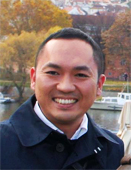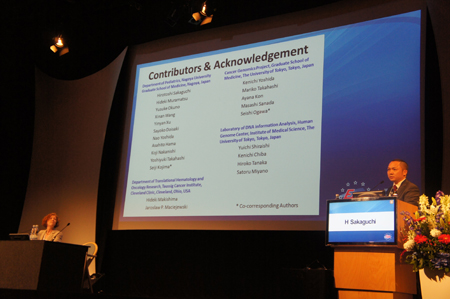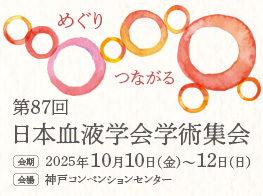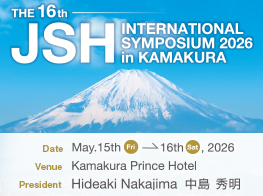
名前:坂口 大俊【名古屋大学大学院医学系研究科小児科学】
発表日時:2013年6月15日
発表形式:oral
Title:
Molecular spectrum of juvenile myelomonocytic leukemia identified by whole exome sequencing
Authors:
Hirotoshi Sakaguchi 1,*, Hideki Muramatsu 1, Yusuke Okuno 1 , 2, Kenichi Yoshida 2, Yuichi Shiraishi 3, Mariko Takahashi 2, Ayana Kon 2, Masashi Sanada 2, Kenichi Chiba 3, Hiroko Tanaka3, Hideki Makishima 4, Nozomu Kawashima 1, Xinan Wang 1, Yinyan Xu 1, Atsushi Narita 1, Sayoko Doisaki 1, Asahito Hama 1, Koji Nakanishi 1, Yoshiyuki Takahashi 1, Nao Yoshida 5, Jaroslaw P. Maciejewski 4, Satoru Miyano 3, Seishi Ogawa 2, Seiji Kojima1
Affiliations:
1Department of Pediatrics, Nagoya University Graduate School of Medicine, Nagoya,
2Cancer Genomics Project, Graduate School of Medicine, The University of Tokyo,
3Laboratory of DNA information Analysis, Human Genome Center, Institute of Medical Science, The University of Tokyo, Tokyo, Tokyo, Japan,
4Department of Translational Hematology and Oncology Research, Taussig Cancer Institute, Cleveland Clinic, Cleveland, OH, United States,
5Division of Pediatric Hematology/Oncology, Children’s Medical Center, Japanese Red Cross Nagoya First Hospital, Nagoya,
Abstract:
Background
Juvenile myelomonocytic leukemia (JMML) is a rare pediatric myelodysplastic/myeloproliferative neoplasm, of which molecular pathogenesis is poorly understood except for mutations of RAS pathway genes including PTPN11, NF1, N/KRAS and c-CBL. Clinical management of patients with JMML according to genetic status is of great international interest, but remains controversial among researchers.
Aims
To obtain a complete spectrum of gene mutations in JMML.
Methods
Whole exome sequencing was performed for paired tumor-normal DNA from 13 JMML cases. Candidate somatic mutations were detected through in house pipeline for whole exome sequencing. All the candidate germline and somatic nuncleotide changes were validated by Sanger/deep sequencing. A total of 92 JMML tumor specimens were screened for mutations in previously reported genes (PTPN11, NF1, KRAS, NRAS, and c-CBL) and newly identified 3 genes with deep sequencing. Moreover, to clarify the clinical significance of aberrant DNA methylation in JMML, we evaluated quantitative CpG methylation pattern of 10 candidate genes by pyrosequencing in the same cohort.
Results
Only 11 non-silent somatic mutations were detected in whole exome sequencing (0.85/sample), of which 6 involved the known RAS pathway genes (2 PTPN11, 1 NRAS, 1 KRAS, and 1 NF1). Germline involvement was suspected in 7 cases (54%), of which 6 had germline mutations of RAS pathway genes (2 PTPN11, 2 NF1, and 2 c-CBL). Totally, the RAS pathway mutations were found in 11 out of 13 discovered cases (85%). Five out of the 11 somatic mutations were in three non-RAS pathway genes (3 SETBP1, 1 JAK3, and 1 SH3BP1). The mutation of SETBP1 has recently been reported in Schinzel-Giedion syndrome (Nat Genet. 2010) and adult atypical chronic myeloid leukemia (Nat Genet 2012). By deep sequencing, RAS pathway mutations were found in 82 out of 92 cases (89%), where PTPN11 mutations were predominant (n=39, 42%) followed by N/KRAS (n=28, 30%), c-CBL (n=14, 15%), and NF1 (n=9, 10%) mutations. The other 10 (11%) patients were negative for known RAS pathway mutations. In addition, genetic mutations of SETBP1 and JAK3 were recurrently found in 16 patients (17%). These mutations had lower allele frequencies compared to the accompanying RAS pathway mutations, indicating that they were responsible for disease progression rather than the establishment of JMML. Clinically, these mutations were associated with poor overall survival (p=0.10). By epigenetic analysis, aberrant methylation in any of CDKN2A, BMP4, CALCA, and RARB was also a significant poor prognosis factor for transplantation free survival (p=0.009).
Summary/conclusions
Our whole-exome sequencing revealed the spectrum of gene mutations in JMML. Together with high frequency of RAS pathway mutations, the paucity of non-RAS pathway mutations is a prominent feature of JMML. Mutations of SETBP1 and JAK3 were common recurrent secondary events presumed to be involved in tumor progression and associated with poor clinical outcomes. Our finding provides an important clue to understand the pathogenesis of JMML that helps to develop novel diagnostics and therapeutics for this leukemia.
Keywords
Genetic, JMML, MDS, Myeloproliferative disorder
参加レポート:
2013年6月13日から16日までの期間、スウェーデンの首都ストックホルムで開催された18th EHA Congressに参加させていただきました。私にとって、初めてのEHA Congressへの参加となりました。今回、日本血液学会国際委員会のご尽力の下、このような機会を与えていただいたことに深く感謝いたします。
ストックホルムは北欧のベネチアと称されるように水の都で、大小様々な島々をいくつもの橋でつなげて形成された都市です。数世紀にわたり戦火や自然災害から免れてきた数少ない都市でもあり、中世の教会や宮殿の建物がそのまま残る美しい街です。公共交通機関も整備されており、アーランダ国際空港から市街地までは特急列車1本で快適にアクセスでき、市街地と近郊はスウェーデン鉄道で、市内は地下鉄とバスで容易に移動できました。
18th EHA Congressの会場はストックホルム郊外のエルブシェ(Alvsjo)という町にあったため、ホテルからは毎日、バスと地下鉄とスウェーデン鉄道を乗り継いで通いました。しかし、Congressの参加証が、特急列車以外の公共交通機関の無料パスとして利用できるようになっていたため、市内の至る所で首から参加証をぶら下げている一群が簡単に見つかり、初めての乗り換え時も迷うことなく済みました。
会場のStockholmsmassanは大きな国際会議場・展示場であり、メイン会場は大型スクリーンが5枚つり下げられた大きなホールで、このメイン会場でのPresidental symposiumでは日本から吉田健一先生や小林匡洋先生が発表されており、日本血液学会のActivityの高さを発信する場になったと思います。
18th EHA Congressのプログラムは初日にサテライトシンポジウム、2日目は教育講演で、3日目と4日目に各種シンポジウムや一般口演が組み込まれていましたが、私は2日目から参加させていただきました。教育講演は午前2コマ、午後2コマで最大で合計4コマ聴講できるようになっていて、さらに午前と午後で同一プログラムのため、聴きたい講演が重なっても問題ないようになっていました。私は小児血液腫瘍、先天性造血不全症、MDSの3コマを聴講しました。小児血液腫瘍の講演では、再発難治性白血病に対する新規薬剤の臨床試験について紹介があり、中でもinotuzumab ozogamicin、SAR3419、blinatumomabなど組換え抗体医薬と、quizartinib、lestaurtinib、midostaurin、sorafenib、ruxolitinibなどの分子標的薬の小児血液腫瘍領域での臨床応用の進捗状況についての報告が興味深く感じました。先天性造血不全症の講演ではFanconi貧血とDiamond-Blackfan貧血について、有用な情報がコンパクトにまとめられていました。特にFanconi貧血での白血病発症に関わる染色体異常と遺伝子変異についてSNP arrayを用いた解析結果のupdateが興味深かったです。MDSの教育講演は京都大学の小川誠司教授が担当され、次世代シーケンサーを用いたMDSの網羅的な分子遺伝学的解析について、非常に興味深い知見をまとめて聞くことができました。
一般口演の中で、私が個人的に興味深く感じたのは、重症先天性好中球減少症の患者の20%が15歳までにMDSもしくは急性白血病を発症し、こうした患者31例の次世代シーケンサーでの解析により、20例にRUNX1変異、23例にCSF3R変異が同定され、内17例は重複していたという報告でした。先天性骨髄不全症を含め、先天性疾患には正常より発癌傾向の高い疾患が多数あり、その分子遺伝学的病態解明のモデルとして興味深い報告であると感じました。
私の口演では、若年性骨髄単球性白血病(以下JMML)を対象に次世代シーケンサーを用いて網羅的遺伝子解析をしたところ、SETBP1とJAK3の新規体細胞変異が同定され、それらはJMMLの進展および予後不良に関わっていることについて報告しました。この成果は学会の直前にNature GeneticsからAcceptの連絡があり、7月7日には電子版にて発表されました(Exome sequencing identifies secondary mutations of SETBP1 and JAK3 in juvenile myelomonocytic leukemia. Nature Genetics. 2013 Jul 7. Epub ahead of print)。とは言え、未だJMMLの10%の症例では原因遺伝子は不明のままであり、これらの症例でどのような手法を用いて解明していくかが今後の大きな課題の一つです。
最終日、自分の発表を終えてから、市内を少し観光しました。ストックホルムはなんと言っても、ノーベル賞の受賞式および晩餐会が行われる都市として世界的知名度が高い都市です。市庁舎やコンサートホールには行けませんでしたが、夕方、何とかノーベル記念館に辿り着いて、山中伸弥先生の直筆サインの残る椅子の写真を撮れたことは良い思い出となりました。
今回、18th EHA Congress Travel Awardに採択していただき、大変光栄に思います。私が発表させていただいたプロジェクトは、大変多くの共同研究者のご尽力により形となったもので、今回の栄誉も研究チームに対していただけたものと考えています。中でも研究遂行を直接ご指導下さった当科の村松秀城先生、次世代シーケンサーでの解析を担当いただいた小川研の吉田健一先生および奥野友介先生、研究を統括いただいた小島勢二教授(名大小児科)および小川誠司教授(京大分子病理)に最大限に深く感謝いたします。




